Berlin (1-2 April 2006) Part 2 - Friedrichstraße and Checkpoint Charlie
Friedrichstraße is a major shopping district in Berlin, with many modern buildings and of course, the Singapore embassy. It is more well-known as a major channel during the Cold War between East and West, going through Checkpoint Charlie, a place where the Third World War nearly erupted, next to the Cuban Missle Crisis.
"On 22 October 1961, the US Mission Chief, E. Allan Lightner, was stopped in his car (which had occupation force licence plates) while going to a theatre in East Berlin. General Lucius D. Clay, Kennedy's Special Adviser in West Berlin, decided to demonstrate American resolve.
Immediately afterwards, 33 Russian tanks drove to the Brandenburg Gate. Curiously, Khruschev claimed in his memoirs that as he understood it, the American jeeps had seen Russian tanks coming and retreated. Col. Jim Atwood, then Commander of the US Military Mission to West Berlin, disagreed in later statements.
10 of these tanks continued to Friedrichstraße, and stopped just 50 to 100 yards from the Checkpoint. The US tanks turned back towards the Checkpoint, stopping an equal distance from it on the American side. And they just waited. From the 27th at 17:00 until the 28th at about 11:00, the respective troops faced each other.
As per standing orders, both groups of tanks were loaded. The US Garrison in West Berlin, then NATO, and finally the US Strategic Air Command (SAC), were brought to increased alert (Defense Condition 3?). Both groups of tanks had orders to fire when fired upon. If there had been a negligent discharge, the consequences might therefore have been very serious indeed, although both superpowers' leaders understood that Berlin was not worth general war.
John F. Kennedy and Nikita Khruschev (according to one source, via a channel established just a month before), agreed to reduce tensions by withdrawing the tanks. The Soviet checkpoint had direct communications to General Anatoly Gribkov at Soviet Army High Command, who in turn was on the phone to Khruschev. The US checkpoint contained a Military Policeman on the telephone to the HQ of the US Military Mission in Berlin, which in turn was in communication with the White House. Kennedy offered to go easy over Berlin in the future in return for the Soviets removing their tanks first. Thinking they had won a political victory, the Soviets agreed. In reality Kennedy was very much in favour of the Wall: "It's not a very nice solution, but a wall is better than war."
A Soviet tank moved 5 yards backwards first; then an American followed suit. One by one the tanks withdrew. But Gen. Bruce Clark, US Commander in the FRG (Federal Republic of Germany: West Germany), was said to have been concerned about Clay's conduct and Clay returned to retirement in May 1962. Gen. Clark's assessment may, however, have been incomplete: Clay's firmness had a great effect on the German population, led by Berlin Mayor Willy Brandt and FRG Chancellor Konrad Adenauer."
Source: Wikipedia
While the original booth has since been removed and stored in the Allied Museum, a decent copy stands on the exact spot, along with the famous sign.
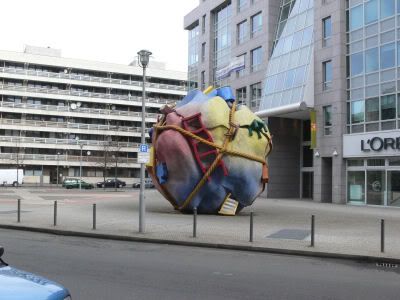
Some artistic monument at Friedrichstraße
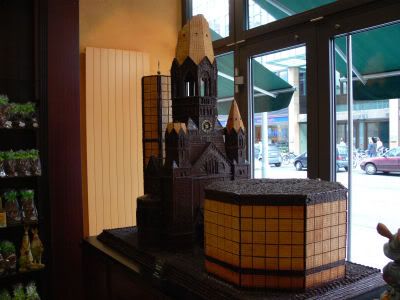
Kaiser Wilhelm Memorial Church made out of chocolate
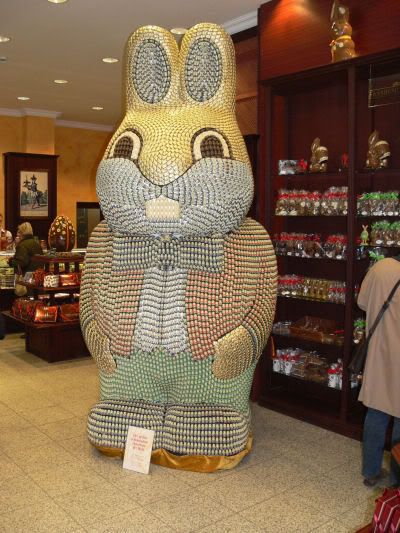
Super-chocolate Easter Bunny

Singapore embassy
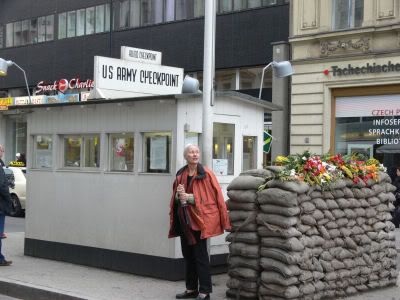 Checkpoint Charlie
Checkpoint Charlie
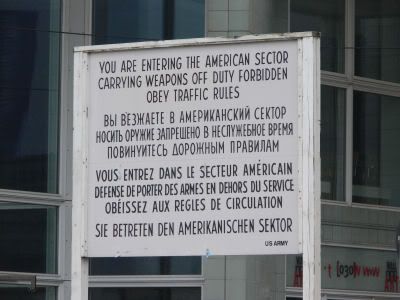
The famous sign
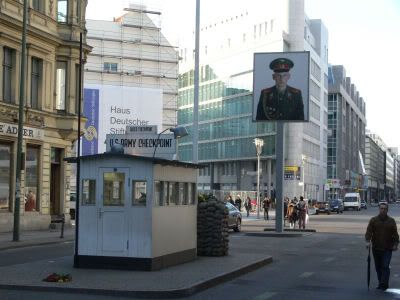
On the American side, note the Soviet portrait
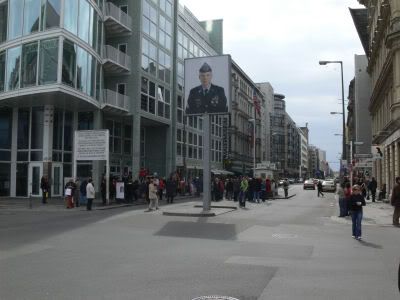
The Soviet side with the American portrait
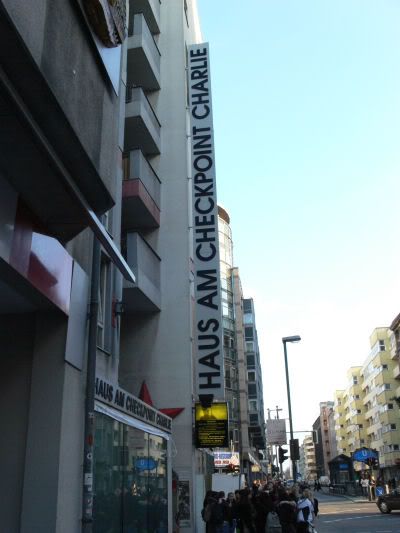
The Checkpoint Charlie Museum
Photobucket: Checkpoint Charlie
"On 22 October 1961, the US Mission Chief, E. Allan Lightner, was stopped in his car (which had occupation force licence plates) while going to a theatre in East Berlin. General Lucius D. Clay, Kennedy's Special Adviser in West Berlin, decided to demonstrate American resolve.
Immediately afterwards, 33 Russian tanks drove to the Brandenburg Gate. Curiously, Khruschev claimed in his memoirs that as he understood it, the American jeeps had seen Russian tanks coming and retreated. Col. Jim Atwood, then Commander of the US Military Mission to West Berlin, disagreed in later statements.
10 of these tanks continued to Friedrichstraße, and stopped just 50 to 100 yards from the Checkpoint. The US tanks turned back towards the Checkpoint, stopping an equal distance from it on the American side. And they just waited. From the 27th at 17:00 until the 28th at about 11:00, the respective troops faced each other.
As per standing orders, both groups of tanks were loaded. The US Garrison in West Berlin, then NATO, and finally the US Strategic Air Command (SAC), were brought to increased alert (Defense Condition 3?). Both groups of tanks had orders to fire when fired upon. If there had been a negligent discharge, the consequences might therefore have been very serious indeed, although both superpowers' leaders understood that Berlin was not worth general war.
John F. Kennedy and Nikita Khruschev (according to one source, via a channel established just a month before), agreed to reduce tensions by withdrawing the tanks. The Soviet checkpoint had direct communications to General Anatoly Gribkov at Soviet Army High Command, who in turn was on the phone to Khruschev. The US checkpoint contained a Military Policeman on the telephone to the HQ of the US Military Mission in Berlin, which in turn was in communication with the White House. Kennedy offered to go easy over Berlin in the future in return for the Soviets removing their tanks first. Thinking they had won a political victory, the Soviets agreed. In reality Kennedy was very much in favour of the Wall: "It's not a very nice solution, but a wall is better than war."
A Soviet tank moved 5 yards backwards first; then an American followed suit. One by one the tanks withdrew. But Gen. Bruce Clark, US Commander in the FRG (Federal Republic of Germany: West Germany), was said to have been concerned about Clay's conduct and Clay returned to retirement in May 1962. Gen. Clark's assessment may, however, have been incomplete: Clay's firmness had a great effect on the German population, led by Berlin Mayor Willy Brandt and FRG Chancellor Konrad Adenauer."
Source: Wikipedia
While the original booth has since been removed and stored in the Allied Museum, a decent copy stands on the exact spot, along with the famous sign.

Some artistic monument at Friedrichstraße

Kaiser Wilhelm Memorial Church made out of chocolate

Super-chocolate Easter Bunny

Singapore embassy
 Checkpoint Charlie
Checkpoint Charlie
The famous sign

On the American side, note the Soviet portrait

The Soviet side with the American portrait

The Checkpoint Charlie Museum
Photobucket: Checkpoint Charlie

0 Comments:
Post a Comment
<< Home